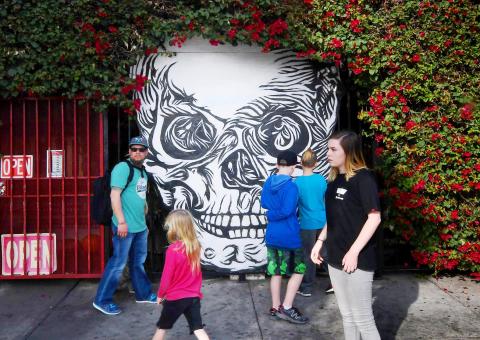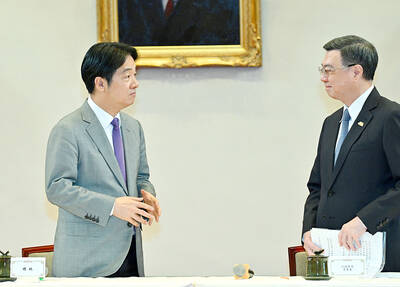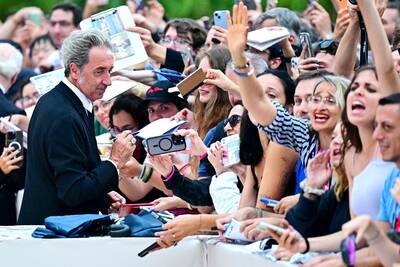Breast implants, a photo of the brain of John F Kennedy, a cheerleader’s outfit and the sketches of a serial killer: all are on display in some of Los Angeles’s quirkiest museums.
The cultural offerings in this city are immense, from highbrow museums featuring works by world renowned artists to others with a decidedly mass-market appeal — like the wax museum, with its likenesses of glaze-eyed celebrities.
But there are edgier and more extravagant establishments throughout the city, with some exhibits that wow and others that terrify.

Photo: AFP
MEMENTOS FROM THE HEARTSICK
There is, for example, The Museum of Broken Relationships, with displays about the heartsick and lovelorn.
One dealt with a divorcee who packed her wedding dress into a pickle jar: She did not want to toss it, let someone else wear it or allow moths to feast on it. There is the cheerleader’s uniform that another woman never got to wear because her boyfriend jilted her; or the partly used bottles of cologne of a man who died of cancer, kept as mementoes by his widow.
And among the displays not to be overlooked is a pair of breast implants housed in a glass case. Their former owner had had them implanted to please her partner, a “boob guy.” But for five years her body tried to reject them and in the end, she had to undergo repeated surgeries to remove them.
“I mutilated my body for a man I loved,” she said poignantly. “At the time, I loved him more.”
The Museum of Broken Relationships has had a nomadic history. It got its start after the artists Olinka Vistica and Drazen Grubisic broke off their romance and founded the museum as a repository for the objects they had acquired during their relationship. In 2010 they opened a venue in Zagreb, followed this year by one in Los Angeles.
“The pieces themselves aren’t necessarily art,” museum director Alexis Hyde told AFP.
But “the museum itself is this very sophisticated piece of conceptual art that is really cutting to
the heart of the matter of what it is to be human,” Hyde said.
DEATH IN EVERY FORM
Then there is LA’s Museum of Death, founded in 1995, with not-for-the-faint-of-heart exhibits on serial killers, group suicides, funerary displays and other subjects related to death.
One display deals with the suicides of famous people like rock star Kurt Cobain and historical characters like Adolf Hitler. There is another on fatal automobile accidents and still another about celebrated murder cases — like that involving accused wife murderer and former football and movie star OJ Simpson. “It’s a way to quell the fear of death,” said museum manager Ryan Lichten.
“It’s going to happen to everyone. The closer you are to what scares you, the less scary it is.” The extensive collection includes the head of Henri Desire Landru, decapitated on the guillotine in Versailles in 1922 for murdering 11 women, although he might have killed hundreds.
Part of Lichten’s work — he is also a curator — involves writing to convicted killers to ask them to send materials that can be used in exhibits. That is how he obtained drawings of the singer Rebecca Schaeffer sketched by her killer on death row.
On one wall are autopsy photos of John F Kennedy performed just hours after his assassination in 1963 in Dallas, Texas: lifeless eyes, blood-matted hair, brains exposed. The photos are accompanied by graphs, newspaper front pages and a copy of the controversial Warren Report, which concluded that accused assassin Lee Harvey Oswald acted alone. Most visitors seem fascinated by the bizarre and grotesque displays, though every week one or two of them faint, Lichten said.
A FURRY OBSESSION
For Valentine’s Day 1993, Steve Lubanski gave girlfriend Candace Frazee a stuffed bunny with a huge heart on its chest that read “I love you.” That Easter, she gave him a porcelain rabbit. Thus was born a tradition, and eventually a museum.
Today visitors can see their 33,000 rabbit-related pieces on display in Lubanski’s house, later converted to a museum. Some 27,000 people have visited since 1998.
Frazee says it is the largest US museum other than the White House that is also serves as someone’s home.
Next year they plan to move their vast collection to a former art gallery, including their four live rabbits and 22 stuffed ones.

Under pressure, President William Lai (賴清德) has enacted his first cabinet reshuffle. Whether it will be enough to staunch the bleeding remains to be seen. Cabinet members in the Executive Yuan almost always end up as sacrificial lambs, especially those appointed early in a president’s term. When presidents are under pressure, the cabinet is reshuffled. This is not unique to any party or president; this is the custom. This is the case in many democracies, especially parliamentary ones. In Taiwan, constitutionally the president presides over the heads of the five branches of government, each of which is confusingly translated as “president”

Sept. 1 to Sept. 7 In 1899, Kozaburo Hirai became the first documented Japanese to wed a Taiwanese under colonial rule. The soldier was partly motivated by the government’s policy of assimilating the Taiwanese population through intermarriage. While his friends and family disapproved and even mocked him, the marriage endured. By 1930, when his story appeared in Tales of Virtuous Deeds in Taiwan, Hirai had settled in his wife’s rural Changhua hometown, farming the land and integrating into local society. Similarly, Aiko Fujii, who married into the prominent Wufeng Lin Family (霧峰林家) in 1927, quickly learned Hoklo (commonly known as Taiwanese) and

The Venice Film Festival kicked off with the world premiere of Paolo Sorrentino’s La Grazia Wednesday night on the Lido. The opening ceremony of the festival also saw Francis Ford Coppola presenting filmmaker Werner Herzog with a lifetime achievement prize. The 82nd edition of the glamorous international film festival is playing host to many Hollywood stars, including George Clooney, Julia Roberts and Dwayne Johnson, and famed auteurs, from Guillermo del Toro to Kathryn Bigelow, who all have films debuting over the next 10 days. The conflict in Gaza has also already been an everpresent topic both outside the festival’s walls, where

The low voter turnout for the referendum on Aug. 23 shows that many Taiwanese are apathetic about nuclear energy, but there are long-term energy stakes involved that the public needs to grasp Taiwan faces an energy trilemma: soaring AI-driven demand, pressure to cut carbon and reliance on fragile fuel imports. But the nuclear referendum on Aug. 23 showed how little this registered with voters, many of whom neither see the long game nor grasp the stakes. Volunteer referendum worker Vivian Chen (陳薇安) put it bluntly: “I’ve seen many people asking what they’re voting for when they arrive to vote. They cast their vote without even doing any research.” Imagine Taiwanese voters invited to a poker table. The bet looked simple — yes or no — yet most never showed. More than two-thirds of those